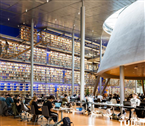 To do this, the library wanted to transform its wall of books into an interactive digital collection wall. In her keynote talk on the second day of the Computers in Libraries 2025 conference, Alice Bodanzky, Project Manager for the TU Delft's Library Learning Center described the goals of the transformation, the process to achieve the vision, and challenges faced. The initial impetus was noticing that physical books were being used less and less. To change the mindset of students, the library decided to employ innovative uses of technology to cause students to look at the librasry collection differently. Enabling interaction with digital and physical collections was central to the endeavour.
To do this, the library wanted to transform its wall of books into an interactive digital collection wall. In her keynote talk on the second day of the Computers in Libraries 2025 conference, Alice Bodanzky, Project Manager for the TU Delft's Library Learning Center described the goals of the transformation, the process to achieve the vision, and challenges faced. The initial impetus was noticing that physical books were being used less and less. To change the mindset of students, the library decided to employ innovative uses of technology to cause students to look at the librasry collection differently. Enabling interaction with digital and physical collections was central to the endeavour.
Beyond the visibility goal, the library wanted the Digital Collection Wall to inspire exploration, enquiry and serendipity. A third goal was to enable collaboration, interaction and contribution, so that users could feel they were integral to the collection by creating narratives and becoming part of the discourse.
Reimaging books
The collaborative element adds a truly new dimension to how students view the library collection. For example, they can choose a physical book, place it on a book stand in front of a screen, and have the AI summarize the text and suggest a future career path based on the books they scan. What an interesting way to show how libraries can change your life.
Want to increase book circulation? TU Delft solicited books recommendations from faculty. They placed the recommendation, along with the faculty member's photo and a quote as to why they recommended it, on a dummy spine shelved near the book. Sure enough, circulation increased. Not only that, professors started reaching out to do more collaborations with the library's wall.
Going beyond physical books in the collection is the XR Cone, a proof-of-concept station designed to visualize and navigate nonstandard format collections, such as videos, maps, and 3D scans. It transforms the floors of the central cone of the library into shelves of animated visualizations that encourage interaction.
The library collaborated with RNDR Studio for the Oraclel1.0 prototype, which offers insight into the future of data visualisation for the institutional repository. This custom-coded project utilizes machine-learning techniques and visual clustering to generate unique covers for publications. A touch screen interface encourages interaction with the images for further exploration.
Student involvement
Highlighting student work is key to the work of the library. It actively solicits student input and incorporates the student perspective. Computer science students took on the task of improving search capabilities for better interaction with the wall. Industrial design students helped bring heritage objects to the wall. Bodanzky notes that heritage objects are the foundation of today's knowledge. Students are intrigued by relating objects in heritage collections to their future interests. To spark curiosity, the library is using AI to generate provocative questions.
Student interest in dissertations and theses—they particularly wanted to know what was the first dissertation in their field—sparked a section of the wall devoted to those objects. Users can delve into topical and cross-faculty clusters, filter by disciplines, and even time-travel to view the university’s oldest theses. Digital twins help students navigate the wall, since they can be overwhelmed by the size and scope of it. Physics students then took some data from the digital twins to create a soundscape for the sound of matter.
Impact of the digital collection wall
The library has also noticed that as more exploration of the wall occurs, more people join events. It's another indication of the opportunity to connect that the wall offers. Additionally, the library recognizes the importance of the social aspects of interacting with the wall. TU Delft's Digital Collection Wall has become a cross-disciplinary platform for collaboration and is evolving into a knowledge hub.
It's a challenge to make visible the digital assets of the library, which are, by their very nature, invisible. TU Delft Library offers an innovative approach that can inspire other libraries in their efforts to promote digital collections. It may not be on the scale of what TU Delft is doing but it could spark ideas on how to tell stories about library collections, events, and opportunities.
To see Bodanzky 's slides, navigate to the Computers in Libraries website and click on the Presentations tab. Scroll down to Wednesday at 8.45 for her presentation.
During her talk, she showed a number of videos. These can be viewed on YouTube.